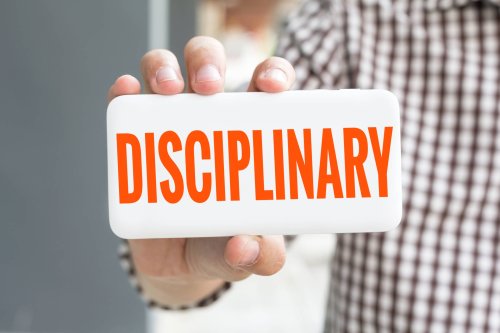When your business employs people, it’s inevitable that at some point you may need to take disciplinary action.
If you find yourself in this position, it’s vital you have an effective disciplinary process that complies with employment law.
When conducting a disciplinary process, it’s really important to cover all the steps. Not only to complete this process in the most effective way, but also in a way that protects you and your business from any potential claim against you, which could prove to be very expensive.
Why might you need to take disciplinary action?
Generally speaking, disciplinary procedures cover two broad categories of conduct:
Category 1: Misconduct or improper behaviour
This encompasses a wide variety of unacceptable workplace behaviours, from theft to poor timekeeping, bullying to harassment.
Category 2: Capability or performance
If your employee is unable to do their job to a satisfactory standard it may be down to inadequate training, unacceptable absence, or something else. Here it’s important to identify the reason and offer support before taking formal steps.
Misconduct may also occur outside of the workplace and an employee can still face disciplinary action. For example, bad behaviour at a company social event, or bullying a colleague on social media.
Gross misconduct is where misconduct is deemed extremely serious or may have a serious effect. In such cases, a disciplinary procedure should still be carried out, but you may decide on dismissal without notice or pay.
Examples of gross misconduct include fraud, violence, or gross negligence.
Employment law
When we talk about disciplinary action it’s easy to imagine it means disciplining someone by giving them a stern talking to. In reality it’s not about punishment, or if you intend to maintain a healthy working environment it really shouldn’t be.
The goals of your disciplinary procedure should be to make sure all your employees are treated equally and fairly, to set standards of conduct that everyone understands, to resolve issues internally, and importantly to demonstrate that a legal process has been followed. Failing to do so could see you facing an employment tribunal. You probably already know this could cost your business thousands, as well as taking up a lot of your time. It’s something we all want to avoid wherever possible.
The process – before you begin
It’s really important that from the very beginning to the very end, you follow a fair procedure.
When you’ve tried to resolve an issue informally without success, it’s time to start a disciplinary procedure. You’ll need to inform your employee straight away. This should be done in writing and include information about the allegation and the potential outcomes of the meeting.
Give your employee time to prepare. The meeting should be conducted as soon as possible, you’ll still need time to investigate, and for your employee to prepare their case.
As part of your investigation, take some time to check if a similar situation has occurred in your business before. If it has, you’ll need to look at what outcome was reached before.
Through the procedure, keep lines of communication open with the employee being disciplined and with any other employees who’ve been affected by the case. This can help to prevent misunderstandings, loss of morale, stress and even further legal action.
You may find that your employee wishes to resign during a disciplinary procedure before it concludes. Be careful in such cases, as this has the potential to lead to a constructive dismissal claim. Encourage your employee to complete the disciplinary first. If they refuse, ask them to sign a document that states they are leaving of their own accord and were not pushed into the decision.
The process – investigation
Your investigation into the allegation should begin as quickly as possible. The idea is to find out what happened and decide whether a disciplinary meeting is needed.
Someone not involved in the case should carry out the investigation. This may be an HR person or a Manager. In a small business, the employer may have to take this role.
A different person is needed to handle each step – the investigation, the disciplinary hearing and outcome, and any appeal.
Creating an investigation plan can help, including what needs to be investigated, the witnesses you’ll need to speak to, any evidence you can collect, the policies you’ll need to follow, confidentiality that needs to be considered, and the timeframe in which each step should be completed.
In cases where it’s possible your employee could tamper with evidence or coerce witnesses, it’s OK to conduct your investigation before you inform the employee of the issue. In very serious cases, it may be appropriate to suspend your employee while investigations are being carried out.
Make sure your investigation adheres to guidance, but also to your own policies. Keep written records of conversations, as well as physical evidence you may discover, like emails, phone records, or text messages.
When you invite employees to an investigation meeting, there is no legal right for them to be accompanied however you may decide to allow it.
After you’ve completed the investigations, you should write a report on your findings, that should be shared with your employee.
The person investigating may conclude the report with their recommendation which would be one of the following:
Formal action – such as a disciplinary hearing
Informal action – like training or coaching, counselling, mediation, or notification that further conduct issues will result in disciplinary action.
No further action.
The process – disciplinary hearing
Your disciplinary hearing should be held as soon as possible after the investigation, while giving your employee the necessary time to prepare.
Write to your employee detailing the alleged conduct, evidence from your investigation, information that you will be discussing, the date, time and location of the hearing, and details on your employee’s right to be accompanied. You should also include the possible outcomes of the meeting.
During your meeting, you as the employer should explain the issue at hand. Go through the evidence and make sure someone else is there to take notes.
Allow your employee to set out their case, answer your allegations, ask questions, and show their own evidence. They may also wish to call their own witnesses too.
A companion may set out the employee’s case, take notes, respond to points you’ve raised, converse with the employee throughout the meeting, and sum things up at the end, if the employee is in agreement.
At the end of the hearing, you should take some time to consider the case before you make your decision on the action to be taken. Tell your employee when and where you’ll reconvene.
It’s important that you take all of the findings into account and decide on a fair outcome. You should then inform your employee of your decision as soon as possible.
If there is no further action, end the disciplinary procedure. Make sure there is no bad feeling with everyone involved by speaking to them privately. Make it clear that there is nothing to be concerned or worried about anymore, and that work should continue as usual.
If there is informal action taken you should keep a confidential record of this for your future reference.
You may decide on a formal written warning. This should state what the issue was, the changes expected in what timeframe, what will happen if there is further misconduct, and how long the warning will stay in place. You should also detail any agreed actions, such as training or support that is to be provided.
If the conduct is serious, you might jump straight to a final written warning, bypassing the earlier stages entirely.
Other outcomes of the hearing may be to move the employee into a less responsible role, but you must check that this complies with your employment contracts first.
Finally, your decision may be to dismiss your employee. That’s if the behaviour amounts to gross misconduct or followed a final written warning. This should only be decided by a Manager with authority to do so. Your employee should be informed of the decision as soon as possible, and be given the reason for the dismissal, informed when their contract will end, their notice period and their right to appeal.
Your employee may appeal if they feel the outcome is too severe, the procedure was handled incorrectly or unfairly, or if there is new evidence.
As you can see, there’s a lot involved in a disciplinary procedure and it’s really important that you don’t miss anythign out. When a procedure like this is mishandled, it has the potential to become an even bigger headache for you, potentially leading to costly legal action.
Always take expert advice from a HR professional if you find yourself needing to begin a disciplinary process. That way you can feel assured that you’re taking the correct steps at the right time, that you’re acting fairly and treating everyone equally.
As always, if this is something we can help you with, arrange a free initial chat with me HERE

